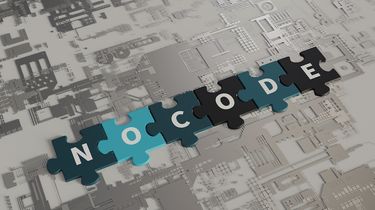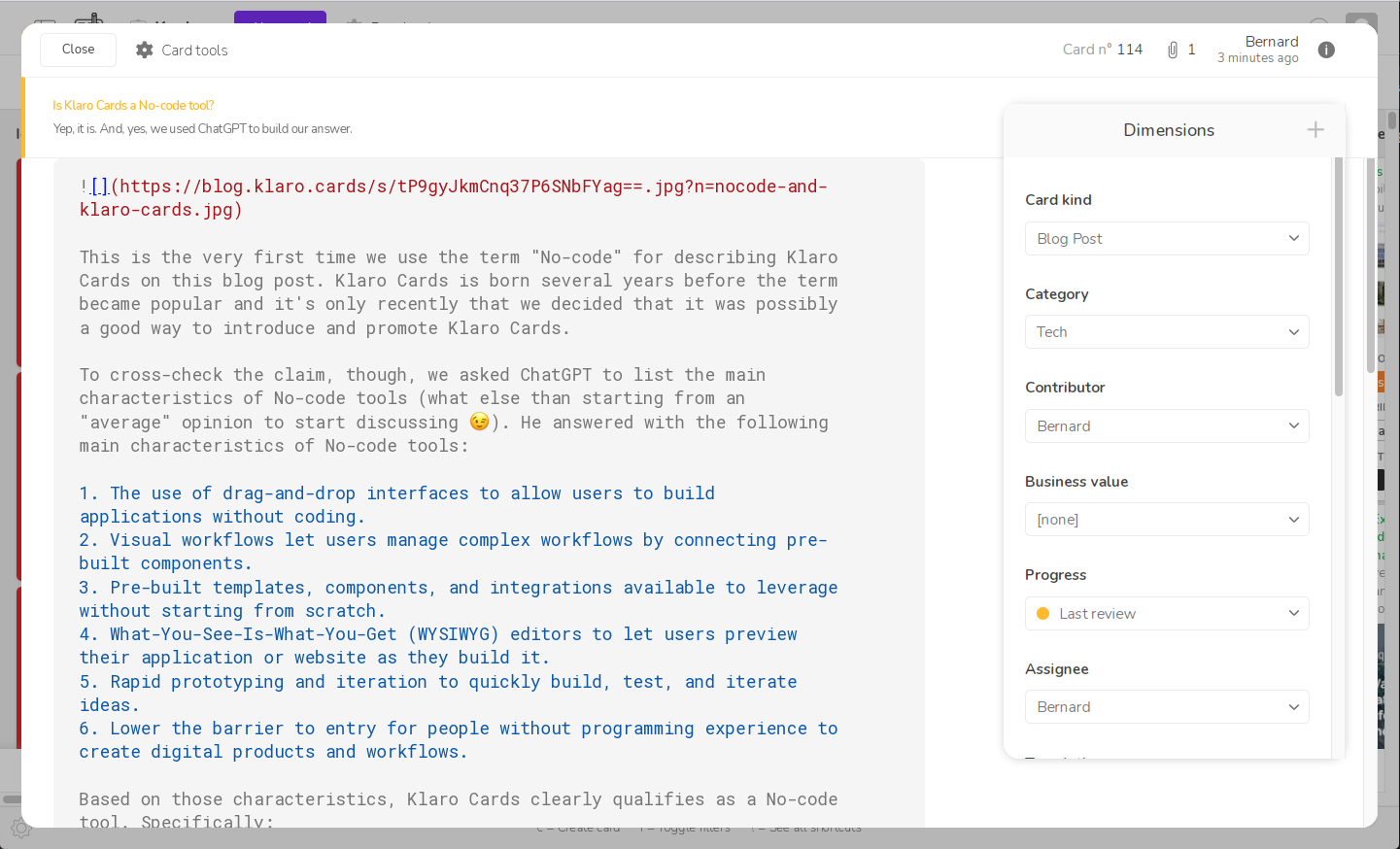Tech
26.02.2023
Is Klaro Cards a No-code tool?
Yep, it is. And, yes, we used ChatGPT to build our answer.

This is the very first time we use the term "No-code" for describing Klaro Cards in this blog post. Klaro Cards was born several years before the term became popular and it's only recently that we decided that it was possibly a good way to introduce and promote Klaro Cards.
To cross-check the claim, though, we asked ChatGPT to list the main characteristics of No-code tools (what else than starting from an "average" opinion to start the discussion 😉).
It answered with the following main characteristics of No-code tools:
- The use of drag-and-drop interfaces to allow users to build applications without coding.
- Visual workflows let users manage complex workflows by connecting pre-built components.
- Pre-built templates, components, and integrations available to leverage without starting from scratch.
- What-You-See-Is-What-You-Get (WYSIWYG) editors to let users preview their application or website as they build it.
- Rapid prototyping and iteration to quickly build, test, and iterate ideas.
- Lower the barrier to entry for people without programming experience to create digital products and workflows.
Based on those characteristics, Klaro Cards clearly qualifies as a No-code tool. Specifically:
-
Collecting, enriching and outputting is done by moving cards using drag & drop. You'd be amazed how much information can be treated that way.
-
Klaro Cards is about visual workflows more than anything else. Each board is an opportunity for the process & team to move forward, by visualizing, discussing and moving cards.
-
We do support project templates. They are specifically intended to offer a pre-configured tool-based approach to non-trivial methodologies: information governance, product owning in an agile setting, risks & cybersecurity, board governance, etc.
-
Ooops, more on this later.
-
The Klaro Cards approach is highly iterative. We frequently advise our users to start small in a bottom-up approach, and we observe that most teams change their dimensions and boards several times a year.
-
Klaro Cards is not trivial to use but it's way easier than programming, of course. We have plenty of users who have absolutely zero programming experience.
So, that's it. Except maybe the WYSIWYG aspect, which brings us to a funny point though.
The obvious feature that calls for discussion about WYSIWYG is the editor of the card description. This one:

Horror, that really looks like code, doesn't it?
Yes, that's a Markdown editor. Markdown is a small language that allows one to write and structure some text while abstracting 100% from layout (fonts, colors, margins, etc.). We often discussed about replacing it by a WYSIWYG editor but we never did it (so far).
In my opinion, Markdown is very emblematic of a complex balance to be found in No-code/Low-code approaches. That balance is about deciding the level of user effort you consider reasonable, the reason you consider it reasonable, and the return those users will get for their effort in learning. Obviously your choices have a very strong impact on the target audience, your ideal personas.
For instance, Markdown requires users to learn a few cabalistic signs to create titles & bullets, and highlight text (aka, italic and bold). In return, they are invited to focus on content only, and abstract from styling concerns. In addition to saving countless hours fighting with the bullets and margins in Word or Google Docs, we can open them to a world where documents are generated automatically, with absolutely consistent styling for no effort at all (yep Klaro Cards does that). (To be honest, it's actually possible to provide a WISYWIG editor that limits styling to what Markdown supports ; we might do that in the future as a better balance).
That leads us to target users, and my personal opinion about No-code. While it's usual to see No-code tools targetting "people without any programming experience", I have the strong intuition that a "yet" is missing in that claim: "people without any programming experience, YET". That is, while No-code tools certainly allow people without programming experience to build applications, websites and workflows, we will also see those tools bringing lots of new people to programming.
In fact, when discussing with Klaro Cards users, I discovered that many of them enjoy building their Klaro projects, configuring boards and dimensions. They love being creative, they love categorising, organising, automating, sharing mental pictures and data with their teams. I would not be surprised to see some of them evolving towards data analysis roles, learning SQL maybe, or coding in high-level scripting languages.
Given that I learned programming thanks to Wordperfect macros (as a way to automate styling before Word and WYSIWYG editors even existed), I asked ChatGPT to elaborate on the synergetic links between Wordperfect macros, Markdown, No-code and the future of programming.
For some mystic reasons, it was down.
